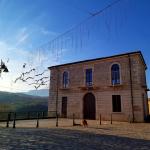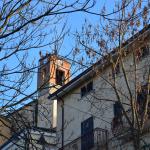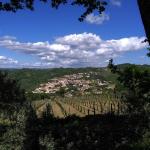The Municipality of Castelfranci is located within the area of the Calore Valley. It's a town with 1,927 inhabitants, located 450 metres above sea level, at 33 km from Avellino. The territory extends for 11.69 sq km and the adjoining municipalities are: Montemarano, Nusco, Paternopoli and Torella dei Lombardi. It's crossed by the river Calore.
The etymology of the name probably comes from Castrum de Francis, “Castle of the Franks”, because of the particular position on the border between Benevento and Salerno. The inhabitants are called Castellesi and Saint Nicholas of Bari is their patron saint.
PLACES OF INTEREST
- Vittoli Palace - Aristocratic building built in 1818, as also shown in the coat of arms of the entrance portal, it is located in the historic centre of the town, behind the Sanctuary
- Sanctuary of Santa Maria del Soccorso (Our Lady of Perpetual Help) - Among the most important monuments of Castelfranci, it was built in the 16th century
- Church of San Nicola (Saint Nicholas) - It has very ancient origins, probably dating back to the mid-16th century
- Palmieri Palace - Ancient building, recently renovated, located in the historic centre
- Celli-Vinoterapia Palace - 18th-century historic building, adjacent to the Mother Church of Santa Maria del Soccorso, which has had a total renovation and, today, is home to a centre that uses wine as a beauty treatment
- Church of San Pietro (Saint Peter) - The building dates back to the 16th century but, due to earthquakes, was closed to the worship of the faithful in 1955: currently under renovation
- “Palata” Park - Located in Bosco Baiano, it has a picnic area near the Calore river
- Fountain of Paradise - It is located on the course of the Calore river, along with the ruins of the ancient mills
- Calore River Trail - Trekking path near the Calore river
EVENTS
- Castelfranci Wine Festival - Food and wine initiative that leads participants to discover the territory of Castelfranci with its beauty, traditions and food and wine products, starting from the wines of excellence
- La Notte re la Focalenzia - Traditional event that takes place in December, characterised by bonfires, food stands with typical local dishes and popular music
- Grape Harvest Festival - Three-day autumn festival that is dedicated to the grape harvest
- Aglianico Wine Feast - Festival dedicated to Aglianico, it takes place on 10-11-12 August
- Maccaronara Festival - Summer food and wine event, featuring the town’s typical dish
- Feast of Saint Nicholas of Bari - Celebrations in honour of the patron saint on 8 and 9 May
- Feast of Our Lady of Perpetual Help - Feast held on the first Sunday of August, at the homonymous square where the Church is located
TYPICAL FOOD AND PRODUCTS
- Maccaronara - Handmade durum wheat pasta accompanied by red meat sauce
- Taurasi DOCG - Wine of great tradition, made thanks to a very ancient grape variety: well structured, elegant and austere but, at the same time, balanced and tannic; suitable for a very long ageing, also thanks to its structure, minerality, good alcohol content and fullness
- Mugliatielli - A particular lamb dish, typical of the territory
- Irpinia Colline dell’Ufita PDO - Extra virgin olive oil deriving largely from the Ravece variety, characterised by a pleasant bitter and spicy taste
- Fig of San Mango PAT - Typical fruit of the area, with juicy pulp and characteristic flavour
- Coda di Volpe Rossa Grape PAT - Grapes rich in bloom and with a thick dark red skin, this variety can be used as a table grape, or for the production of the homonymous wine
- Caciocavallo Silano PDO - Semi-hard cheese, with spun curd, produced with milk from different breeds of cows, including Podolica
FUN FACTS
The Church of Santa Maria del Soccorso, unlike other places of worship, was erected by will of the people.
It is said that the secret association of Castellese, participating in the insurrectionary uprisings of 1820, met frequently at Vittoli Palace.
Among the leading figures of the Carboneria castellese was Captain Casimiro Celli, accused of high treason by the Bourbon government and sentenced to 30 years of imprisonment, partly condoned by King Francis I of Bourbon.
HISTORICAL NOTES
The history of Castelfranci has ancient origins: the archaeological finds unearthed in the territory of Baiano, a district of the municipality, confirm the settlement, already during the Roman period, of several very small tribes. The town arose, however, during the 9th century AD, with the name of Castrum Francorum, representing a fortification erected to guard the Duchy of Benevento by the Franks, who arrived in Italy alongside Ludwig II the Germanic.
In Norman times, it was administered by Guaimario Saraceno, Lord of Montemarano; after being ruled by several local lords, it was acquired by Giovanni Virgato, Giovanni Della Leonessa and the Della Marra family. One of the oldest documents concerning Castelfranci dates back to 1248 and is the Papal bull issued in Lyon on 6 June, with which Pope Innocent IV returns to Bella De Amicis, widow of William of Montemarano, the land of Castrum de Francis owned by the De Montana family.
Hard hit by the plague of 1348, the town flourished significantly only in the 16th century, in the period of Spanish domination.
Castelfranci is an enchanting place where one can admire its truest spirit, tasting the Taurasi with its garnet reflections. It’s time to leave as gourmets to rediscover together this flavour of Irpinia
Castelfranci
Piazza Municipio, 1, 83040 Castelfranci AV, Italia
Events
Saturday 7 June in the Irpinia village an unmissable event with artistic and gastronomic…
-
An eagerly awaited event for the local community and beyond, the Castelfranci Wine Festival is…
-
Part of the Castelfranci Wine Festival is dedicated to the ancient tradition of grape…
-
A traditional food and wine event during which many small bonfires enrich and warm up the…
Presentation of the book on Friday 23 February at 5.30 pm in the council room
Saturday 8 March in Castelfranci the traditional masked parade to the rhythm of tarantella
Featured places
Via Roma, 28, 83040 Castelfranci AV, Italia
In the heart of Castelfranci, a period residence for holidays and events, whose vigorous walls…
Piazza Largo Soccorso, 83040 Castelfranci AV, Italia
It is a symbolic place of devotion for the community of Castelfranci. Built in the 16th…
Via Foria, 83040 Castelfranci AV, Italia
Its origins are ancient and it was once a burial place, as evidenced by some of the sacred…
Did you like it? Leave a review
Your opinion is important! It will be visible after approval by the editorial staff.
To post a comment you must be an authenticated user. Log in with Social Login


